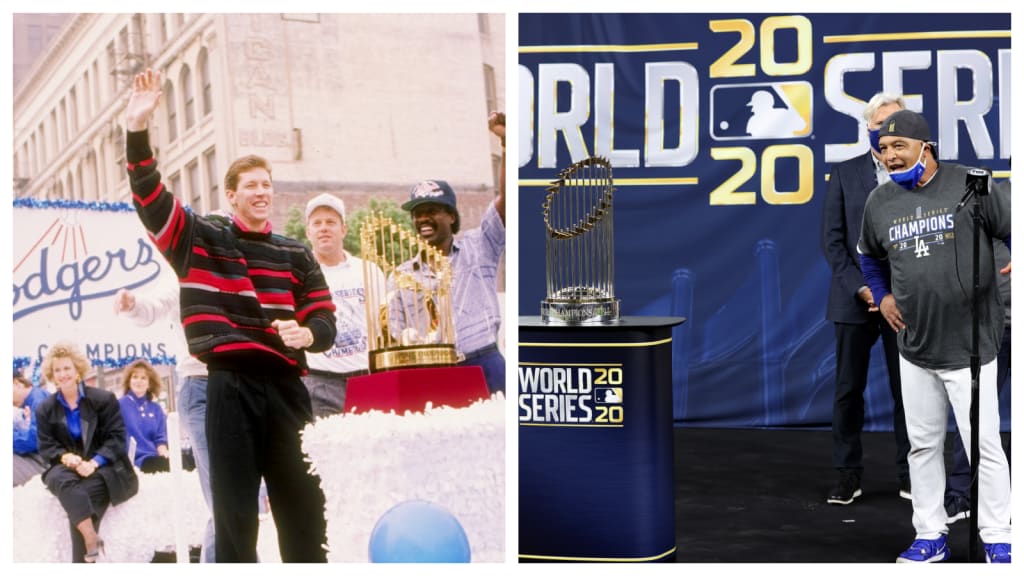
The Dodgers' World Series drought is over. The counter can stop clicking. After eight consecutive NL West titles, and in their third World Series this decade, Los Angeles is the World Series champion once again. As you’ve no doubt heard dozens of time this October, it’s their first World Series title since 1988, when Kirk Gibson and Orel Hershiser teamed up to play postseason heroes.
Though the unis were the same, not much else was. Sure, there were different faces suited up for the club but that's not all. The very way the game is played today is drastically different from 32 years ago.
Let's break down the changes:
1. No Vin Scully
OK, let's start with the most obvious of the bunch. Yeah, obviously the legendary broadcaster wasn't on the call this year because he retired in 2016. That also meant that this was the first World Series the Dodgers have ever won -- whether in Brooklyn or in Los Angeles -- without Vin Scully on the horn.
While Scully was around after the game to wish the Dodgers congratulations, he was literally on the mic the last time L.A. was crowned champions:
2. Bullpens
It's no secret that the size of bullpens and the importance that they play in a team's success have grown astronomically over the years. Multiple times this postseason, teams -- including both clubs in the World Series -- used bullpen games where they knew no pitcher would last more than a handful of frames.
The starkest difference can be seen here: In 1988, the Dodgers used seven pitchers in total across their five-game series against the A's.
The Dodgers used seven pitchers in Tuesday's Game 6 alone.
3. Starting pitcher usage
Perhaps the biggest storyline from Game 6 will be how the Rays went to their bullpen: As soon as Blake Snell finished getting through the Dodgers lineup a second time, he was lifted. It didn't matter that he had only given up two base hits and no runs -- this was what Tampa Bay does.
While the Rays are perhaps the most fastidiously attached to the idea, it's not like Dave Roberts was slow with his hook either. Clayton Kershaw was the only Dodgers starter to pitch twice in the Series, and he never made it past the sixth inning in either start despite giving up three combined runs in his two outings.
Meanwhile, 1988's ace pitcher and World Series MVP, Orel Hershiser also pitched in two games. He, however, threw complete games both times.
It's a trend that's not unique to this World Series. Justin Verlander is the last pitcher to throw a complete game in the postseason when he went nine full innings in Game 2 of the 2017 ALCS, and Jose Lima is the last Dodgers pitcher to accomplish the feat back in the 2004 NLDS.
3. Power
If you want to win games these days, you're going to need to go deep. In fact, teams went 35-5 this October when they out-bashed their opponent:
It's a much different approach to roster building than the '88 Dodgers used. That regular season, only two Dodgers players hit 20-plus home runs: Gibson and fellow outfielder Mike Marshall.
Now, obviously, no Dodgers player hit 20 home runs in this year's shortened 60-game season. But if we look at what they were on pace to do in a full season, eight different Dodgers would have reached the mark. That includes utilityman Chris Taylor and backup third baseman Edwin Ríos, who smashed eight home runs in 83 plate appearances. And fine, if you don't want to count this season, then four different Dodgers reached 20-plus home runs last year -- and that doesn't include Mookie Betts, who smashed 29 dingers for the Red Sox in 2019.
Because Gibson's clutch home run is the first thing that comes to mind when people think of the '88 World Series, you may think the Dodgers got the bats cooking against Oakland in the Fall Classic. Once again, not really.
Los Angeles hit only five home runs in the World Series against Oakland, and Mickey Hatcher led the way with two.
This year, the Dodgers smashed 12 home runs against the Rays, with Corey Seager, Betts and Justin Turner all going deep twice.
4. Strikeouts
Ah, when we've got all the extra pitchers throwing their extra-hard, extra-swervy pitches against guys aiming for the fences? There's going to be a few more whiffs, too.
In 1988, the Dodgers struck out only 36 times in the five-game World Series, or just over seven times per game. John Shelby led the way by striking out seven times on his own.
This year, Los Angeles struck out 61 times -- just over 10 times per game. Taylor led the way with 11 whiffs, but Betts, Turner and Will Smith all K'd at least seven times.
The 2020 Dodgers pitchers also cleaned up in the K department. They struck out Rays batters 70 times compared to just 41 A's in '88.
The two teams also combined to strike out 27 times on Tuesday night, setting a World Series record along the way:
5. Stolen bases
So, this one is a little weird. Given everything you've read above, you might think this year's Dodgers team scored on home runs and nothing else. But that's not the case.
In fact, Los Angeles stole five bases this World Series compared to just four in 1988. But that doesn't tell the full story. There two things to consider:
- Los Angeles attempted eight steals in the '88 World Series, meaning they were successful only 50 percent of the time. Now, the number has changed over time, but it's generally thought that you need around a 65-to-70 percent success rate on steal attempts. Otherwise you're only costing your team runs. By that math, it would have been better for L.A. to have never attempted to steal a base than to steal the four they did.
Compare that to this World Series, and the Dodgers were caught only once, good for an 80 percent success rate.
- In '88, six different players attempted steals. That included catcher Mike Scioscia, who was caught stealing. That's perhaps not shocking considering he once had a Minor League teammate pedal on an exercise bike to get his mileage up for skipper Tommy Lasorda, who wanted his catcher to slim down.
In 2020, only two Dodgers attempted steals in the World Series: Betts, who was 4-for-4 and Austin Barnes, another catcher who was nabbed.
6. Shifts
If you watched the World Series, then you probably heard plenty about the shift. It made itself known almost every time a ball was hit for an out where, in years past, it would have rolled for an easy base hit.
Now, we don't have data on shifts from the '88 season. We know teams did shift -- they've been shifting for at least as long as Ted Williams was in the league and likely longer -- but they definitely didn't use the tactic like they do now.
And no one -- not even the Rays -- shift as often as the 2020 Dodgers do. Los Angeles led the Majors in shifts both this season and last (they were 19th as recent as 2016, which would still blow the '88 team out of the water), and had shifted on 52 percent of pitches in the postseason entering Game 6.
7. The music
Of course, the more things change, the more they stay the same. The Dodgers won the 1988 World Series on Oct. 20. Two days later, Phil Collins' "A Groovy Kind of Love," reached No. 1 on Billboard's Hot 100. And though it's not No. 1, Collins was back on the charts this August after "In the Air Tonight" went viral following Tim and Fred Williams' video reaction to the song.
And if you're telling me that Seager's anti-gravitational quarantine 'do wouldn't make him great as a member of Wham! well, we're just going to have to agree to disagree.



